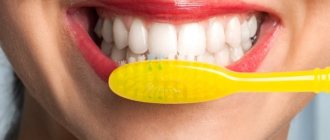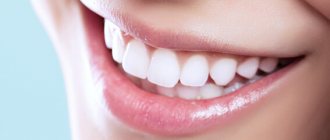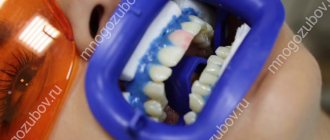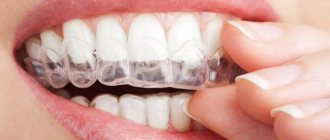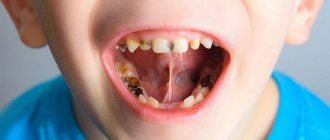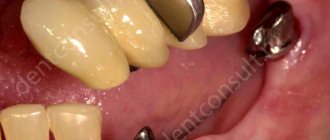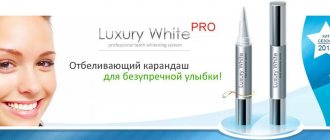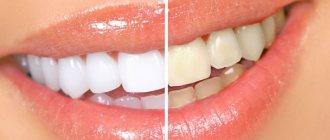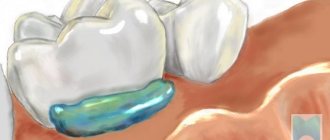Advertising and films show us people with perfectly straight and white teeth. A brilliant smile has long been an attribute of success. For some, it has replaced dental health as a priority. Although whiteness is not a sign of health. And yellowish and grayish shades do not necessarily indicate illness.
Dentists say that the shade of teeth depends on the genetic characteristics and place of birth of a person. For example, Russians have naturally slightly yellowish teeth. And the Americans have a gray tint. And this does not affect their health at all and is not an indicator of any deviation.
But on the way to brilliantly white teeth there are important contraindications. If you don’t know about them, you will lose the smile you have now. The editors of estet-portal have collected for you the most important indications for teeth whitening.
- What happens during teeth whitening
- Types of teeth whitening and procedures
- Contraindications to teeth whitening: for whom the procedure is strictly prohibited
- Negative Effects of Teeth Whitening: Weigh Them
- Is teeth whitening beneficial or harmful?
What happens during teeth whitening
There is a persistent misconception that bleaching removes the top, “dirty” layer of enamel, as if cleaning it, bringing out a cleaner and lighter one. This also gives rise to the idea that whitening is part of a measure for dental health. In fact, the only procedure, other than the direct treatment of diseased teeth, that needs to be done regularly is professional hygienic cleaning. It helps get rid of soft and hard deposits on the teeth, which reduces the risk of developing caries and often removes bad breath.
Whitening is an exclusively aesthetic procedure that does not improve the condition of teeth, but can worsen it.
To give a simple and understandable example to many, the same thing happens during teeth whitening as during hair lightening with hydrogen peroxide.
Most often, even substances with similar composition are used - urea-peroxide or simply peroxide systems.
The effectiveness of clinical whitening
Photobleaching
These are the well-known Zoom and Beyond systems, where hot light from a halogen, diode or ultraviolet lamp is used as a catalyst. The advantages of this method are an affordable price (about 5,000 rubles), as well as simultaneous exposure to light on the entire dentition. However, there is a risk of overheating the enamel, which leads to increased sensitivity to temperature stimuli.
This is the most harmless, but most expensive in-office teeth whitening (the price of the procedure is from 8,000 rubles). The laser beam does not heat dental tissue, so the risk of pulp burns, enamel hypersensitivity and other complications is completely eliminated. The downside is that not all dental clinics are equipped with a laser machine due to its high cost.
Endobleaching
This is intracanal whitening using lightening pastes. It is used for those teeth that have darkened after depulpation (removal of the dental nerve), endodontic treatment or crown injury. Cost – 3,000-4,000 rubles. (for 1 tooth).
Types of teeth whitening and procedures
Let's take a quick look at the basic teeth whitening techniques. There are two main types of procedures: in-office whitening and home whitening. Office activities refer to the actions that a dentist performs in his office. More often it is called exactly that - in-office bleaching. The home whitening stage consists of applying a special gel using a custom-made tray for your teeth. The gel is applied overnight, the procedure usually lasts 5-10 nights.
Ideally, you need to combine these two stages - first go through the necessary manipulations in the dentist’s chair, and then consolidate the result at home. Not everyone goes through such a full whitening cycle, but it allows you to consolidate the result for a long time. To maintain the desired tone, you will only need to periodically apply the gel.
Whitening techniques
Here are a few basic techniques that are now offered in dental clinics:
- Chemical bleaching. A special gel is applied to the teeth, which allows them to be lightened by 4-8 tones in one session. The gums are first protected, since the chemical can cause burns. This whitening option is not suitable for those who have cracked or chipped teeth.
- Laser whitening. Here, too, there is no need for a chemical composition, only it is activated using a laser. During the procedure, an unpleasant tingling sensation may occur.
- Photobleaching. The now popular ZOOM whitening is carried out using this technology. A special gel containing hydrogen peroxide is again applied to the teeth, then the enamel is illuminated with a lamp. After the procedure, a remineralizing composition is applied to the teeth, which should protect them from increased sensitivity.
Types of whitening: risks and features of each type
There are several approaches to teeth whitening. The most gentle of them is homemade. It is ideal for those who do not want to expose themselves to unnecessary risks and are ready for their teeth to lighten just a tone or two. There are different ways to whiten your teeth at home:
- Using abrasive toothpastes and gels. Sometimes it’s enough just to change your usual hygiene products to make your teeth look better. However, you should pay attention not to the advertised mass-market toothpastes, but to the professional ones that dentists use to clean teeth before medical procedures.
- Using special systems. Most often, they are a mouth guard that is filled with a whitening compound and placed on the teeth. The activity of this composition is not very high, so there is no need to worry about burns. You need to wear such a mouth guard for several hours a day for weeks, or even months. It all depends on the result you want to achieve.
Home whitening has virtually no risks, but its effectiveness is low. In addition, it requires consistency from you - you need to repeat the procedure every day. Many people do not have the opportunity to devote several hours every day to wearing mouth guards, so they are looking for faster, but also gentle methods. These include office cleaning procedures:
- Air Flow is an abrasive cleaning using a water jet with various components. It does not whiten teeth in the literal sense of the word, but it allows you to remove plaque on the back wall of the teeth, as well as remove it in the tooth spaces. Due to this, the yellowness between the teeth disappears, and the smile becomes more neat. This cleaning is recommended for absolutely everyone at least once every six months.
- Ultrasonic cleaning . It removes all the same deposits, but not with jet pressure, but by destroying them using ultrasound. Suitable for more old tartar. Recommended for people who smoke or drink a lot of coffee or tea, as these habits leave a very durable and dark coating.
These two procedures are extremely hygienic and are recommended for absolutely everyone. Regular cleanings will keep your teeth in good condition for a long time. The only thing is that you should postpone the procedure if you currently have acute inflammation of the jaw or have a cold. Then it’s worth returning to this issue later.
Air Flow and ultrasound cleanings brighten teeth quite noticeably in just one procedure. But if this is still not the result you were aiming for, you will have to carry out classic whitening. It comes in several types:
- Chemical bleaching. It uses the same reagents as for home whitening (chlorides, urea peroxide, hydrogen peroxide), only their concentration is much higher. This whitening is very high quality and deep. Its effect can last up to 5 years if you then properly care for your teeth. But chemical bleaching is quite dangerous for enamel. You need to keep the composition on your teeth for 1.5-2 hours, and repeat the procedure 3 or 4 times. During this time, the enamel, if it is not very stable, may become thinner or crack.
- Photobleaching. During this procedure, a light-sensitive reagent is applied to the teeth. When it flashes, it releases oxygen, which destroys dark spots on the enamel. This procedure is much shorter in terms of exposure time, so it can be performed even on teeth with already damaged enamel. The only risk is gum burns when heated by a lamp.
Laser whitening. The price for this procedure is the highest. But it is also the safest. The peculiarity of this procedure is that the doctor works with each tooth separately. This means that he can choose a more gentle regimen for damaged teeth, and a full-fledged one for those that are completely healthy.
Contraindications to teeth whitening: for whom the procedure is strictly prohibited
Now that we have an idea of how the teeth whitening procedure occurs, we can turn to the contraindications:
- Caries. The most important contraindication for any type of bleaching. If you have untreated caries, it is too early to think about white teeth. First you need to undergo treatment and get fillings.
- Gum diseases. Despite the fact that during the whitening procedure, the gums are protected mechanically or with the help of special solutions, you still cannot take risks if they are diseased.
- Thin tooth enamel. If, as a result of examination and diagnosis, the dentist realizes that you naturally have very thin tooth enamel, then whitening will not be possible. If you still have a desire, it is recommended to first go through a course of measures to help strengthen the enamel and make it more durable.
- High sensitivity of teeth. In any case, whitening will increase sensitivity, so if someone who wants to undergo the procedure already suffers from this problem, then they will have to refuse teeth whitening.
- Pregnancy and lactation period. It is better for pregnant women to postpone the procedure until later, as it can cause unexpected consequences. In addition, the teeth of pregnant women already suffer due to a lack of necessary substances, which the body now has to divide into two.
- Age up to 18 years . The dentist has the right to refuse the procedure to a child or teenager.
- Allergy to substances contained in whitening gels. If you are allergic to hydrogen peroxide, then the procedure is closed to you. As we mentioned earlier, almost all whitening systems include this component.
- Recent removal of braces. If you wore braces, you can come for whitening only six months after they are removed. The point is that you need to wait until the cement mark disappears completely.
Even if you have not identified any of the listed contraindications, you came for the procedure and during the process felt a sharp pain in one of the teeth - whitening must be stopped immediately. Perhaps a hidden carious cavity is making itself known, which was hidden under an old filling or was simply inaccessible to the dentist’s eye.
Teeth whitening in the clinic and at home
In-office whitening is carried out using a high concentration oxidizing gel (25-35% hydrogen peroxide or urea), which is applied to the enamel. Under the influence of a catalyst (light rays, laser, etc.), the gel is activated, as a result of which oxygen begins to be released.
Oxygen ions penetrate into the deep layers of dentin, breaking down the accumulated pigment. At the end of the procedure, the doctor carries out remineralizing therapy with fluoride preparations. This is necessary in order to strengthen the enamel after exposure to an oxidizing agent.
The patient carries out home whitening independently, but this cannot be done without the supervision of a doctor. First, the doctor will examine you to rule out any contraindications, and then take impressions of your teeth to make a custom mouth guard. In a few days you will be given a ready-made mouthguard and gel to fill it.
At home, low concentration gels (10-15%) from well-known manufacturers Opalescence, White Light and others are used. The course lasts 10-20 days (day or night use). After completion, you should see a dentist to evaluate the result and strengthen the enamel.
Negative Effects of Teeth Whitening: Weigh Them
The whitening procedure does not have the most pleasant consequences. Here are a few of them:
1. Teeth may lose their shine . Yes, dreaming of a perfect, sparkling Hollywood smile can cause your teeth to lose their shine and become chalky. There is even a special term - “chalky teeth”, “chalky stains on teeth”
2. Enamel demineralization will occur . At the same time, the pigment during the lightening process can also remove useful minerals that protect the teeth.
3. Teeth sensitivity will increase. The most common negative consequence of the procedure is that teeth react more sharply to cold, hot and sour. The first few days after bleaching will have to be patient; if high sensitivity persists for a long time, then you will have to take separate measures.
Read also: Chalky stains on teeth: what they mean and how to get rid of them
Is teeth whitening beneficial or harmful?
Of course, you decide for yourself whether a bright smile is worth such sacrifices. However, if there are contraindications related to the health of teeth and gums, a good dentist will under no circumstances agree to perform the procedure. Even if you really ask him. Remember that your main task (and your doctor’s too) is to keep your teeth and gums healthy. As for the aesthetic appearance and the standards of a snow-white smile, largely imposed by television and advertising, let them wait their turn.
Read also: Save your wallet and teeth: how dentists deceive patients
You may be interested in: How to put a filling.
How to care for your teeth after whitening
If you carry out the whitening procedure regularly, you can seriously damage your teeth. There is even a so-called “over-whitening” effect, when teeth lose their shine and become chalky white. Also, over time, demineralization of the tooth occurs, and it loses its strength. If this happens, the doctor usually recommends restorative remotherapy.
Frequent injuries during the phototherapy procedure include burns to the pulp and damage to the gums from chemical reagents or the heating lamp itself. These risks are slightly lower for those who choose laser teeth whitening. The laser does not heat the gums as much as a lamp, which eliminates heat burns. But it’s difficult to avoid getting burned by the bleaching compound. It all depends on the skill of the doctor and how calm and careful you are during the procedure.
After you make your smile snow-white, you will need to make your oral hygiene more thorough, of course, if you want the result to last for a long time.
DETAILS: Teeth soda teeth whitening
During the first 48 hours, you must avoid foods that stain the enamel. Eliminate the following foods:
- Chocolate;
- Coffee;
- Tea;
- Juices, fruit drinks, red wine;
- Lemonades and sodas;
- Confectionery products containing dyes;
- Beets and carrots;
- Adjika, ketchup, soy sauce, etc.
In addition, it is very advisable to refrain from smoking for two days. As a last resort, use an electronic cigarette. Next, for two weeks you need to reduce the number of cigarettes you smoke as much as possible.
Daily hygiene plays an important role in maintaining white teeth. Brush your teeth at least twice a day, and preferably after every major meal. Be sure to use dental floss to prevent food debris from accumulating in areas that are difficult to reach with a brush. The use of rinses is also recommended; this will more effectively combat the growth of harmful bacteria, soothe the gums and help maintain whiteness.
For cleaning, it is best to use whitening and remineralizing pastes.
For 2-3 hours after the procedure, you must follow a “white” diet, that is, exclude all coloring products (tea, coffee, beets, etc.). It is also important to quit smoking during the first 24 hours.
To keep the enamel white for a long time, you can use professional toothpastes with a whitening effect (ROCS, Splat, etc.). Pay special attention to daily oral hygiene.
On our website you can easily find a clinic with affordable prices for professional teeth whitening. Just enter the necessary parameters in the search system.
How does chemical whitening of tooth enamel occur?
Depending on what result you want to get, such whitening can be done both in the clinic and at home.
Professional chemical whitening
You should know! Stages of professional chemical lightening:
- First of all, the doctor must conduct a detailed diagnosis of the condition of your teeth and find out whether there are any contraindications to whitening. It is also recommended to test for an allergic reaction in advance.
- Then a professional oral hygiene procedure (mechanical cleaning) is carried out. Remember that without it it is impossible to get high-quality whitening results.
- Next, the doctor proceeds directly to the whitening procedure . It can be carried out either on the same day or the next.
- The dentist fixes the soft oral cavity (lips) with retractors, and covers the gums with a protective film called cofferdam, or a special protective composition.
- After this, is applied . The concentration of hydrogen peroxide in such a preparation is much higher than when carrying out other types of bleaching using catalysts.
- The gel is applied for fifteen to thirty minutes, depending on the condition of the tooth enamel. During this time, the dentist must closely monitor the patient. If you experience any unpleasant sensations, immediately notify a specialist.
- If after removing the gel the desired effect could not be achieved, then the operation can be repeated , but only once.
- At the end of the procedure, the doctor applies a remineralizing gel to the teeth , which is also recommended for use at home after whitening surgery.
At home
For your information! Before performing whitening at home, you need to purchase a special kit. Take this matter seriously.
Buy it either in specialized stores or in pharmacies so as not to run into a counterfeit product.
When making a purchase online, pay attention to the cost - it should not be too low.
You can also rely on reviews.
Never buy a home whitening kit on sites like Aliexpress - no one can vouch for its quality, and the treatment will cost you much more.
Rules for carrying out the procedure at home:
- Do an allergy test on the crook of your elbow.
- Place the special mouthguard that comes with your kit into your mouth
- Apply whitening gel with a special brush (the concentration of hydrogen peroxide in it should not exceed ten percent). Try not to get it on the exposed part of your gums. Leave it on your teeth for the time indicated in the instructions for the product. If during the procedure you feel any discomfort, immediately wash the product off your teeth.
- After the time has passed (it’s better to turn on a timer or set an alarm), rinse the solution from your teeth.
- At the end of the procedure , apply remineralizing gel .
Remember! Usually, in order to lighten tooth enamel by three to four shades, it is enough to repeat the procedure three times.
In any case, you should not get carried away with home whitening so as not to harm your teeth.
Chemical method
Chemical teeth whitening involves the use of hydrogen peroxide and the oxygen released as it decomposes. The action of the whitening gel is due to a chemical reaction that occurs on the surface of the enamel. All components that involve chemical teeth whitening are mixed in certain proportions directly in the syringe used to apply the whitening composition.
The chemical reaction begins almost immediately after mixing the components, so an active composition is applied to the enamel, which literally “corrodes” the plaque.
Chemical teeth whitening is one of the aggressive methods . The consequence of this effect is the thinning of tooth tissue, which can lead to further destruction. Express teeth whitening is carried out using a strong chemical composition that contains 40% hydrogen peroxide.
If tooth whitening fails
In-canal bleaching is a very effective procedure, but even it does not always give the desired result.
What factors can complicate whitening or even make it impossible:
- Intra-canal whitening is a very effective procedure, but even it does not always give the desired result.
Color of teeth. Determined by the Vita scale: teeth in groups A and D (gray and red-gray) are less amenable to whitening. - Transparency of enamel. Transparent enamel looks darker even after bleaching.
- Enamel integrity. Artificial pigments penetrate through microcracks on the surface of the tooth and mix with natural ones. A high concentration of foreign dyes may prevent complete whitening of the enamel.
- Time of color change. If a tooth has changed color a long time ago, it will be more difficult to whiten it, especially if the cause of pigmentation is the removal or death of the pulp.
- Tetracycline staining. Color changes occur through complex chemical reactions, so the results of exposure to bleach can be unpredictable.
- Uneven pigmentation. Spots and streaks are less susceptible to whitening, and the color of the enamel after the procedure may not remain uniform (for example, the tip of the tooth may remain yellow).
When diagnosing, the doctor must assess how effective the procedure will be in a particular case and inform the patient. In some cases, it is better to use combined methods, for example, combining intracanal whitening with external one.
Important: during whitening, drinking drinks that affect the color of the enamel can negate the entire effect of the procedure!
DETAILS: Is the filling whitened during teeth whitening? What to do before going for whitening. How to whiten at home
